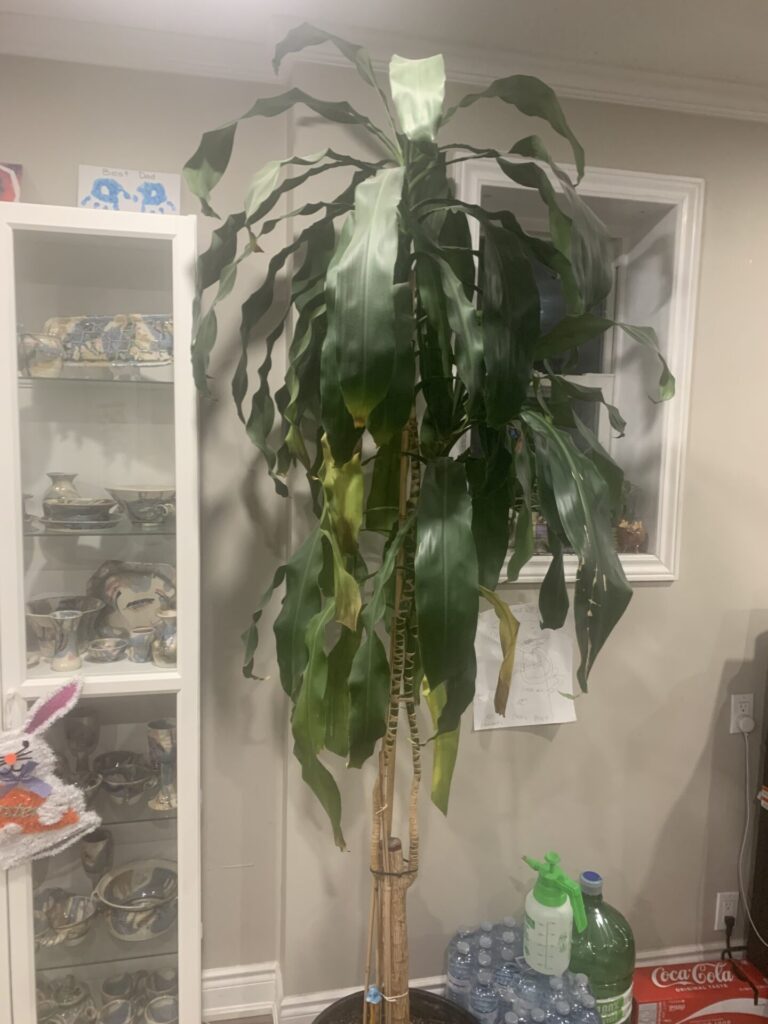
I was gifted this tree in the attached photos a few years ago and have somehow seemed to care for it well. It’s seemed to thrive in it’s location but recently the leaves have started to yellow and sink. I do water but lightly every two weeks with the remaining water from our jugs that we put in our water dispenser.
The top layer seems to be dry but i don’t want to disturb the soil closer to the roots to see if it’s wet or not. I can’t tell if it’s over watered or under-watered especially given the season.
What should I do? How can i confirm the moisture level as I don’t want to over water and cause root rot. Any recommendations are helpful! Also, please confirm that this is a Dracaena? Is plant food recommended? Should I add/ mix in any fresh soil? Would worm castings help?
Thank you so much for any help you can provide?
Thank you for contacting the Toronto Master Gardeners.
Based on your photograph, your plant is indeed a variety of the species Dracaena fragrans, also known as Corn Plant. This article in Plantura Garden gives some useful photos to help identify the particular species and variety of Dracaena you have, as well as general instructions on care of these plants.
The fact that your Dracaena was growing well over the last few years indicates that the light levels and quality of water are unlikely to be causing a problem. These plants enjoy bright, indirect light. You can apply a normal, well-diluted houseplant fertilizer once per month (maximum) during the growing season, from spring until early fall. It is best to stop fertilizing during the winter when the plant is not actively growing.
If you feel your plant has outgrown its pot, you can increase it by one pot size. Use regular potting soil and make sure the pot has good drainage. If you have never re-potted this plant, it may very well be potbound and that may be your problem.
Yellowing of dracaena leaves is not uncommon. In some cases, this is a natural part of the aging of the plant. As new leaves are pushed up at the top of the plant, old ones begin to yellow and drop off at the bottom. Having said that, yellowing and drooping (and even browning of the leaf tips) is a frequent problem, and indeed, it can be caused by too much water, or by low humidity and/or drying out of the soil. As you have noted, this makes it difficult to find a solution without risk of exacerbating the situation.
Dracaenas tend to prefer to be on the dry side compared to other houseplants. They like to be watered thoroughly, but infrequently, especially during the winter when they are not growing as actively. Never let the plant sit in a saucer with the excess water as this can lead to rotting of the roots. The top part of the soil (about 2 inches) should be dry before watering again. This could take as long as 2 weeks, depending on the time of year, conditions in your room, and the size of the pot. Do not hesitate to stick your finger in the pot to determine the moisture level. Another approach is to purchase a moisture meter from a nursery or plant store. A simple first step would be to wait a week or 10 days after the last watering, then give the plant a good, thorough watering, let it drain completely, and then leave it until the top half of the soil has dried out. Then repeat.
You can remove the yellowed leaves completely and discard. You may also wish to refer to this other entry on care of Dracaena fragrans .

